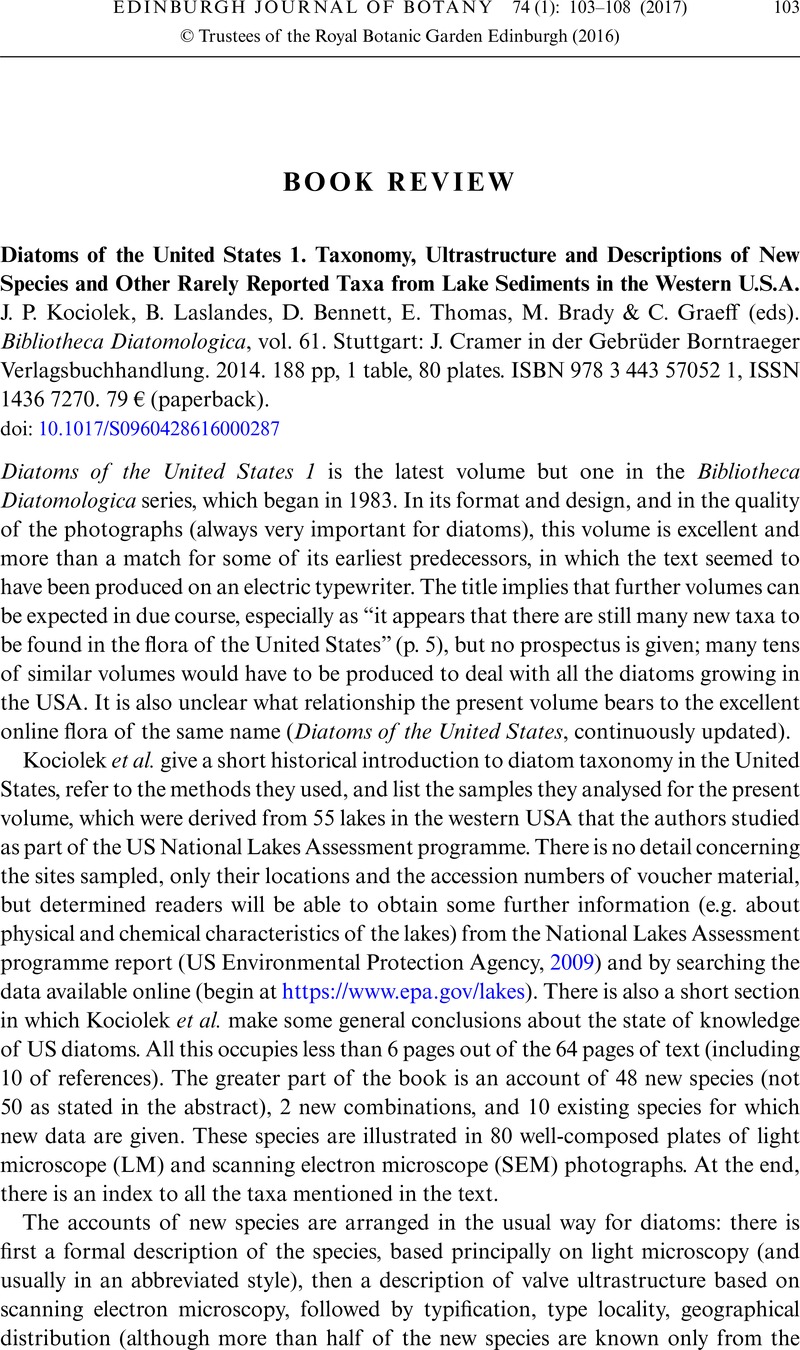No CrossRef data available.
Article contents
Diatoms of the United States 1. Taxonomy, Ultrastructure and Descriptions of New Species and Other Rarely Reported Taxa from Lake Sediments in the Western U.S.A. J. P. Kociolek , B. Laslandes , D. Bennett , E. Thomas , M. Brady & C. Graeff (eds). Bibliotheca Diatomologica, vol. 61. Stuttgart: J. Cramer in der Gebrüder Borntraeger Verlagsbuchhandlung. 2014. 188 pp, 1 table, 80 plates. ISBN 978 3 443 57052 1, ISSN 1436 7270. 79 € (paperback).
Published online by Cambridge University Press: 07 December 2016
Abstract
An abstract is not available for this content so a preview has been provided. Please use the Get access link above for information on how to access this content.

- Type
- Book Review
- Information
- Copyright
- Copyright © Trustees of the Royal Botanic Garden Edinburgh (2016)
References
Botanischer Garten und Botanisches Museum Berlin–Dahlem (no date). Acquisitions June 2015. Online. Available: https://www.bgbm.org/en/new-acquisitions-2001/acquisitions-june-2015
Google Scholar
Diatoms of the United States (continuously updated). Diatoms of the United States: Diatom Identification Guide and Ecological Resource. Online. Available: http://westerndiatoms.colorado.edu/
Google Scholar
Guiry, M. D. & Guiry, G. M. (2016). AlgaeBase. World-wide electronic publication, National University of Ireland, Galway. Online. Available: http://www.algaebase.org (searched 24 August 2016)Google Scholar
Kociolek, J.P. & Williams, D.M. (2015). How to define a diatom genus? Notes on the creation and recognition of taxa, and a call for revisionary studies of diatoms. Acta Bot. Croat.
74
(2): 195–210.CrossRefGoogle Scholar
Krammer, K. & Lange-Bertalot, H. (1986–1991). Bacillariophyceae. In: Ettl, H., Gerloff, J., Heynig, H. & Mollenhauer, D. (eds) Süsswasserflora von Mitteleuropa, vol. 2 (parts 1–4). Stuttgart and New York: G. Fischer.Google Scholar
Lange-Bertalot, H. (1980). New species, combinations and synonyms in the genus Nitzschia
. Bacillaria
3: 41–78.Google Scholar
Mann, D. G. & Vanormelingen, P. (2013). An inordinate fondness? The number, distributions and origins of diatom species. J. Eukar. Microbiol.
60
(4): 414–420.Google Scholar
McNeill, J., Barrie, F. R., Buck, W. R., Demoulin, V., Greuter, W., Hawksworth, D. L., Herendeen, P. S., Knapp, S., Marhold, K., Prado, J., Prud'homme van Reine, W. F., Smith, G. F., Wiersema, J. H. & Turland, N. J. (eds and comps) (2012). International Code of Nomenclature for Algae, Fungi, and Plants (Melbourne Code), Adopted by the Eighteenth International Botanical Congress Melbourne, Australia, July 2011. Regnum Vegetabile 154. Oberreifenberg: Koeltz Botanical Books.Google Scholar
Round, F. E., Crawford, R. M. & Mann, D. G. (1990). The Diatoms. Biology and Morphology of the Genera. Cambridge: Cambridge University Press.Google Scholar
Rühland, K. & Smol, J. P. (2015). Book review, Kociolek, J.P. et al. Diatoms of the United States 1. Bibliotheca Diatomologica 61. Limnol. & Oceanogr. Bull.
24: 121.Google Scholar
US Environmental Protection Agency (2009). National Lakes Assessment: a Collaborative Survey of the Nation's Lakes. EPA 841-R-09-001. Washington: Office of Water and Office of Research and Development, US Environmental Protection Agency.Google Scholar
US Environmental Protection Agency (no date). Lakes. Online. Available: https://www.epa.gov/lakes
Google Scholar
Wetzel, C. E., Ector, L., Van de Vijver, B., Compère, P. & Mann, D. G. (2015). Morphology, typification and critical analysis of some ecologically important small naviculoid species (Bacillariophyta). Fottea
15
(2): 203–234.CrossRefGoogle Scholar


